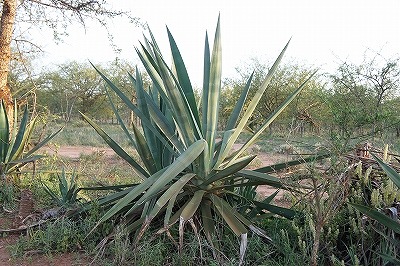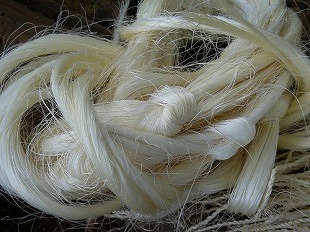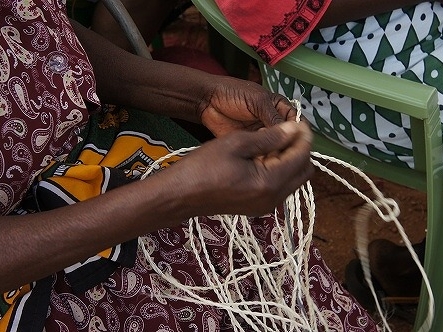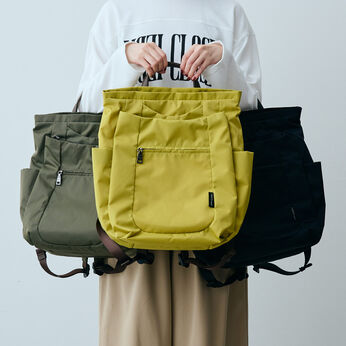[mensha! SELECT] Mini sisal bag made with traditional Kenyan handicrafts (Gold)
お申し込み番号:351378
1 piece ¥5,060
- Monthly BOX
- NEW
- Just One
🧺How sisal bags are made

About sisal
Sisal is a type of agave, and its fiber is called sisal hemp after hemp, a fiber that has been widely used throughout history. Native to Central America, the word sisal is said to have originated from the Mexican port city of Sisal. A member of the agave family, which is the source of tequila and mezcal, sisal leaf fiber has been widely used as a material for rope and other products that require durability. Currently, East African countries such as Kenya and Tanzania are among the world's major producers.
The process of making a sisal bag is divided into many small steps. The sisal material is a large leaf that is about as tall as a person. The material is dyed with dye. The finished sisal bags are inspected one by one before being sent off to Japan.

Sisal leaves are squeezed to extract the fibers

Undyed sisal has a glossy ivory color

The fibers extracted from sisal are twisted into thin rope-like threads.

Finished sisal yarn

The scrap tape used for sweets is also made from silver sisal.

We also skillfully knit new materials.

The finished baskets are inspected and then sent to Japan.

They weave quickly with skilled techniques while chatting happily. In recent years, they have also tried their hand at basket weaving, which combines different materials, to create innovative sisal bags. Kenyan women are full of vitality, weaving in between housework and farm work, or while walking on their way home. Basket weaving supplements their livelihood and is an important source of cash income for these women.
🧺How sisal bags are made

About sisal
Sisal is a type of agave, and its fiber is called sisal hemp after hemp, a fiber that has been widely used throughout history. Native to Central America, the word sisal is said to have originated from the Mexican port city of Sisal. A member of the agave family, which is the source of tequila and mezcal, sisal leaf fiber has been widely used as a material for rope and other products that require durability. Currently, East African countries such as Kenya and Tanzania are among the world's major producers.
The process of making a sisal bag is divided into many small steps. The sisal material is a large leaf that is about as tall as a person. The material is dyed with dye. The finished sisal bags are inspected one by one before being sent off to Japan.

Sisal leaves are squeezed to extract the fibers

Undyed sisal has a glossy ivory color

The fibers extracted from sisal are twisted into thin rope-like threads.

Finished sisal yarn

The scrap tape used for sweets is also made from silver sisal.

We also skillfully knit new materials.

The finished baskets are inspected and then sent to Japan.

They weave quickly with skilled techniques while chatting happily. In recent years, they have also tried their hand at basket weaving, which combines different materials, to create innovative sisal bags. Kenyan women are full of vitality, weaving in between housework and farm work, or while walking on their way home. Basket weaving supplements their livelihood and is an important source of cash income for these women.

![mensha![メンシャ!]|【mensha! SELECT】ケニアの伝統的な手工芸でつくられたミニサイザルバッグ〈ゴールド〉 mensha![メンシャ!]|【mensha! SELECT】ケニアの伝統的な手工芸でつくられたミニサイザルバッグ〈ゴールド〉](https://www.felissimo.co.jp/dw/image/v2/BGGR_PRD/on/demandware.static/-/Sites-409/default/dw21c4c3ca/pic/351378-productcuts-01-99999999-M.jpg)
![mensha![メンシャ!]|【mensha! SELECT】ケニアの伝統的な手工芸でつくられたミニサイザルバッグ〈ゴールド〉 mensha![メンシャ!]|【mensha! SELECT】ケニアの伝統的な手工芸でつくられたミニサイザルバッグ〈ゴールド〉](https://www.felissimo.co.jp/dw/image/v2/BGGR_PRD/on/demandware.static/-/Sites-409/default/dw7c586bbf/pic/351378-productcuts-02-99999999-M.jpg)
![mensha![メンシャ!]|【mensha! SELECT】ケニアの伝統的な手工芸でつくられたミニサイザルバッグ〈ゴールド〉 mensha![メンシャ!]|【mensha! SELECT】ケニアの伝統的な手工芸でつくられたミニサイザルバッグ〈ゴールド〉](https://www.felissimo.co.jp/dw/image/v2/BGGR_PRD/on/demandware.static/-/Sites-409/default/dwdcfa5a7d/pic/351378-productcuts-03-99999999-M.jpg)
![mensha![メンシャ!]|【mensha! SELECT】ケニアの伝統的な手工芸でつくられたミニサイザルバッグ〈ゴールド〉 mensha![メンシャ!]|【mensha! SELECT】ケニアの伝統的な手工芸でつくられたミニサイザルバッグ〈ゴールド〉](https://www.felissimo.co.jp/dw/image/v2/BGGR_PRD/on/demandware.static/-/Sites-409/default/dw59e34367/pic/351378-productcuts-04-99999999-M.jpg)
![mensha![メンシャ!]|【mensha! SELECT】ケニアの伝統的な手工芸でつくられたミニサイザルバッグ〈ゴールド〉 mensha![メンシャ!]|【mensha! SELECT】ケニアの伝統的な手工芸でつくられたミニサイザルバッグ〈ゴールド〉](https://www.felissimo.co.jp/dw/image/v2/BGGR_PRD/on/demandware.static/-/Sites-409/default/dw046abe92/pic/351378-productcuts-05-99999999-M.jpg)
![mensha![メンシャ!]|【mensha! SELECT】ケニアの伝統的な手工芸でつくられたミニサイザルバッグ〈ゴールド〉|サイザルとはリュウゼツランの一種で、歴史的に広く使われていた繊維である麻にちなんでサイザル麻と呼ばれています。ケニアのキクユ人やカンバ人の伝統技術により サイザルで編んだバスケットは穀物の運搬や保存にケニアでは使われていました。かごを編む技術は母から娘へと受け継がれ、ケニアの小さな農村の女性を中心にひとつひとつ手づくりで編み上げています。現在ではサイザルバッグを編むことがケニアの村の重要な現金収入源となり、各家庭の子どもたちの学費となり生活費の足しとなっています。(引用元:アフリカンスクエアー) mensha![メンシャ!]|【mensha! SELECT】ケニアの伝統的な手工芸でつくられたミニサイザルバッグ〈ゴールド〉|サイザルとはリュウゼツランの一種で、歴史的に広く使われていた繊維である麻にちなんでサイザル麻と呼ばれています。ケニアのキクユ人やカンバ人の伝統技術により サイザルで編んだバスケットは穀物の運搬や保存にケニアでは使われていました。かごを編む技術は母から娘へと受け継がれ、ケニアの小さな農村の女性を中心にひとつひとつ手づくりで編み上げています。現在ではサイザルバッグを編むことがケニアの村の重要な現金収入源となり、各家庭の子どもたちの学費となり生活費の足しとなっています。(引用元:アフリカンスクエアー)](https://www.felissimo.co.jp/dw/image/v2/BGGR_PRD/on/demandware.static/-/Sites-409/default/dw5e5e5f05/pic/351378-productcuts-06-99999999-M.jpg)
![L'AMIPLUS[ラミプリュス] | L+MEDE19Fオトナ柄トートバッグ](https://www.felissimo.co.jp/dw/image/v2/BGGR_PRD/on/demandware.static/-/Sites-240/default/dw219d9d2b/pic/247918-thumbnail1-01-99999999-S.jpg?sw=346)











![el:ment[エルメント] | シロフクロウ播州織カットジャガードあずまバッグ](https://www.felissimo.co.jp/dw/image/v2/BGGR_PRD/on/demandware.static/-/Sites-257/default/dwed96e528/pic/724389-thumbnail1-01-99999999-S.jpg?sw=346)






![L'AMIPLUS[ラミプリュス] | レガーロパピロ×ラミプリュス撥水トートバッグ](https://www.felissimo.co.jp/dw/image/v2/BGGR_PRD/on/demandware.static/-/Sites-240/default/dw91feafac/pic/846551-thumbnail1-01-99999999-S.jpg?sw=346)


